
With Toto Temple Deluxe being almost ready for release (aiming for Summer 2015), we decided it was time for us to attend a real big event like PAX East. It was our very first PAX, with our very first 10′ x 10′ booth, for our very first console game release!
We thought it’d be a good idea to share our overall experience, especially since we experimented a bit with marketing, as you can see in the title.
By the way, it’s a long read, so here’s a convenient way to skip to the subject you prefer:
- We were part of a new group called Up North Indies
- How we designed our first 10′ x 10′ booth
- Our strategy to get noticed / attract a big crowd
- The showdown system (for giveaways)
- How we gave away 1,700 free copies of the game
- Were those free copies worth it?
- The quick & easy tournament system
- How we spent $8,000 at PAX
- How we dealt with a greedy corporation
- What went wrong
- What went right
Up North Indies
We had our very own booth at the convention, but we were part of a bigger (and brand new) group called Up North Indies. We’re essentially a group of multiple indie developers from Montreal/Quebec getting together to share knowledge, but also to get easier access to events like PAX. We’ve been learning and getting a lot of help from the other studios by being part of this group. We’re definitely lucky!
We had a little bit of branding at the event to identify each booth as part of the UNI, but we couldn’t get anything big done in time (a huge hanging banner, for instance). We learned a lot from PAX, which was our first group event, so we’ll definitely have better presence at future events.
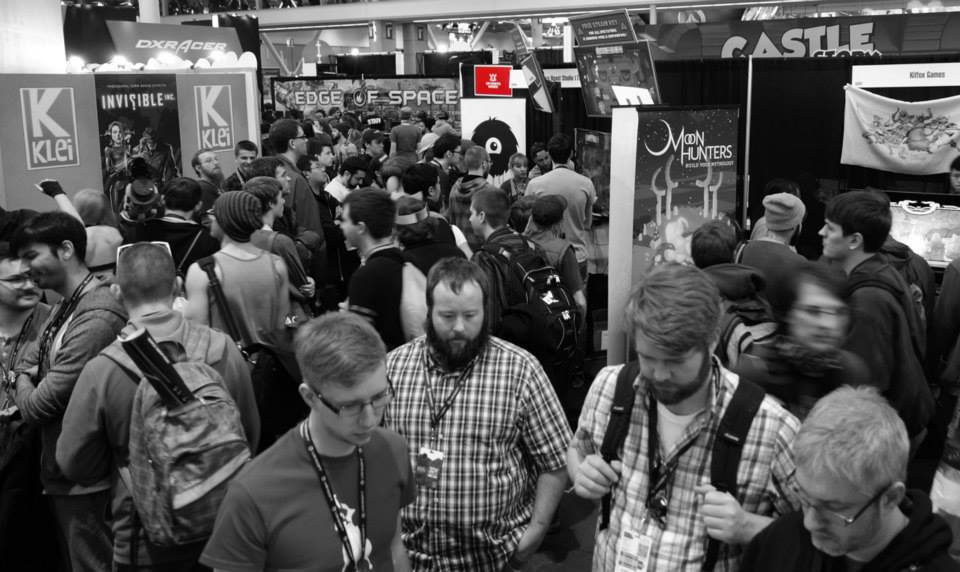
Designing our first 10′ x 10′ booth
The event was in Boston, so about 5 hours drive south of Montreal. We managed to get there by car to save money, but the downside was that our car was pretty small and we couldn’t travel with a lot of equipment. We still managed to get two 7′ tall TV stands, two 42” TVs and one 50” TV. Here’s how we did it.
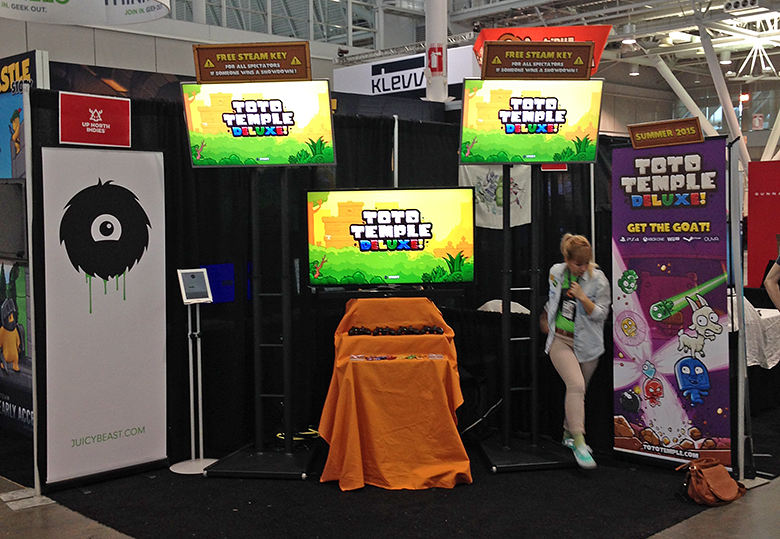
First thing we took in consideration for the design of our booth is that we were on a corner (still lucky). We took advantage of that and tilted everything diagonally to face both sides simultaneously. We think it played a big role in the success of our booth.
We also wanted to have one main TV station for players, and some higher cloned TVs for spectators. Since a single Toto Temple Deluxe match doesn’t last very long, we didn’t bother with chairs and stuff. Everyone played while standing up and rotation was fast.
As this was our first big event with our first “big” booth, we had literally no equipment. We always managed to get by with borrowed stuff, but this time we had to invest in some new equipment.
We got ourselves some pretty tall TV stands from Displays2Go. They’re heavy as hell, but they can support really big TVs up to 7′ in the air! Our booth also came with a table, so we had enough to support 3 TVs in total.
Speaking of TVs, we had no room in the car for 3 big TVs, so we simply decided to “rent” them at a nearby Best Buy in Boston. And by rent we mean buying them and taking them back after the event by saying it didn’t fit our needs after all. No questions ask, thanks Best Buy!
How we got noticed
To put things in perspective a bit, we originally designed our PAX demo so that matches would be really quick. That way, we’d have a better flow and have more players would try the game. Since matches wouldn’t last long enough for the crowd to feel any major engagement, or for hype to build up, we needed a better way of getting spectators more engaged in the game as they were looking at it.

Normally, only the 4 current players would be really engaged in the game. Maybe they were with a friend, and maybe that friend would get engaged and cheer a bit, but we felt like it wouldn’t be enough to build enough engagement / hype overall.
We then heard of a strategy that the guys from Vlambeer were doing at events for Nuclear Throne. They would have hourly challenges where everyone watching would get a free copy of the game if the current player managed to beat the game. That would normally encourage people to stay and look at the game. They would have something to win (or lose), so they should feel engaged.
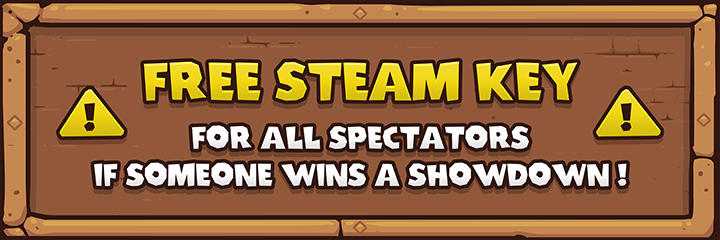
We thought it was really clever and it would totally fit our needs, but we decided to push the idea a bit further. Instead of asking players to come back every hour to have a chance of winning a free copy of the game, we decided that every – single – match would be an opportunity to win a copy of the game.
With that in mind, we needed something to link the giveaways to. Ideally, something that wouldn’t happen every match, but only once in a while so we don’t end up giving away 50,000 copies. That’s when we came up with the showdown system.
The Showdown system
If you’ve followed the development of Toto Temple Deluxe a bit, or simply played the game, you know there’s 2 main game modes. The Classic mode, where you fight for an egg-laying goat to make points, and the Bomb mode, where you fight for an explosive goat in order to kill your opponents with the blast.
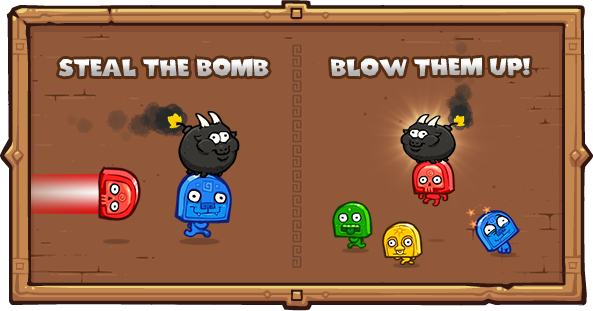
Since we needed something to link the giveaways to, we figured we could use the bomb mode for that. Here’s how the system works:
The winner of each match (in Classic mode) would be automatically thrown in a 1 vs 1 bomb showdown against 1 bot (set at hard). If that player manages to kill the bot 2 times, everybody watching would get a free copy of the game. BAM.
It was also a good way of having players experience both modes and discover the game’s content without having to come back to play a match in the other mode.
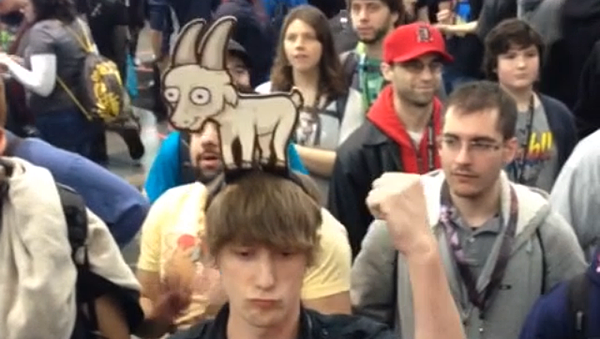

The goat hat was necessary to participate in a showdown.
To make things more official / exciting / funny, we also crafted goat hats for the winner to wear during the showdown. It had the effect of making the crowd laugh, friends would take pictures (always good), and it made the people passing by wonder what it was.
We also needed people to know that they could win a free copy of the game simply by looking at it, so we designed 2 big signs explaining the rules and hanged them over the cloned TVs (which you probably already saw in the pictures above).
Giving away 1,700 keys in 3 days
Every once in a while, a skilled player would win a match AND the following showdown. Here’s what it looked like:
As you can see, the showdown system managed to build hype and engagement from the crowd. It worked really well! Maybe a bit too well.
The amount of showdown victories were reasonable, so we planned them right, but what we didn’t expect what the amount of spectators watching the game!
What happened was that spectators would literally stay and watch until someone eventually won a showdown. The crowd would grow bigger and bigger over time, but it had the weird effect of clearing the whole booth as soon as we handed out the keys after showdown victory. It was funny how empty the booth was after each victory, but a brand new crowd would form really quickly as 4 news players stopped to try the game.
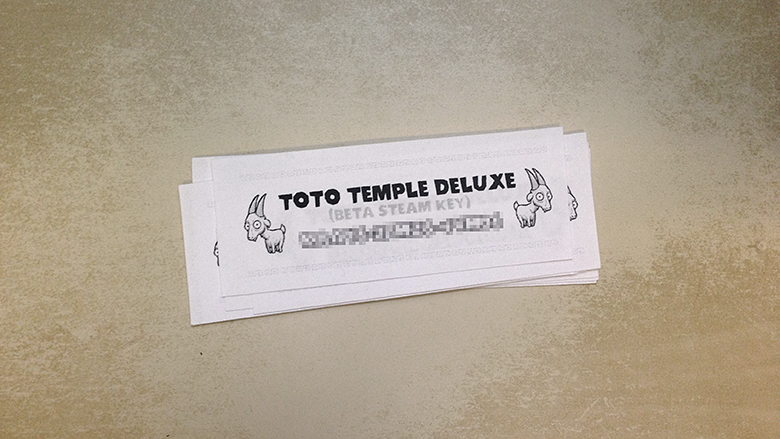
We started out with 900 keys, and thought it would be enough for the whole event. We were dead wrong.
We actually ran out of keys by the end of the second day, and Steam wouldn’t let us generate more during the weekend, so we had to find a temporary solution on next morning. Actually, Marion kicked us out of our beds really early so we’d have enough time to plan the new solution. Good thing she was there!
Our friend Alex from Tiny Build suggested we use a system similar to theirs. We simply had to generate a QR code that would point to a MailChimp newsletter, so that we can contact everyone later and send them their keys. Brilliant! The only detail we added was a unique string code (generated here) to each paper, so that one QR code couldn’t be used by multiple people. We had to cross check them manually, which could be automated with a bit of PHP and a database.
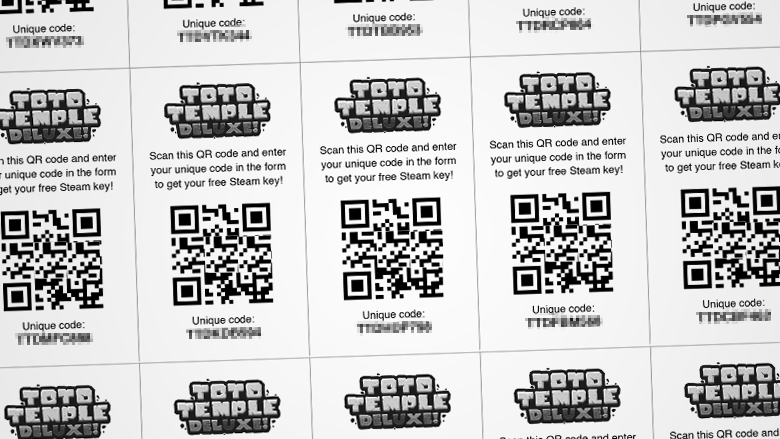
We managed to get 1,000 new keys printed at the on-site Fedex office in the morning, which was super helpful. By the end of the event, we handed out about 1,700 keys, of which about 500 have been redeemed at this date.
1,700 keys. Was it worth it?
It might look like a lot of keys at first, but they probably won’t get all redeemed in the end (fingers crossed for not too many resellers). We also saw a couple players win more than one Steam key. Because why not.
For the attention it got us during PAX, we definitely think it was worth it. We actually saw a lot of people stop by curiosity, in part because of the huge crowd, in part because they could get something for free. As they stood there and wait for something to happen, they usually tried to make sense of the gameplay. By the time they would reach the controllers as the crowd rotated, most of them already knew how to play.
In other words, those big “free keys” signs acted as some kind of salesman, stopping players and introducing them to our game. All of that without us having to say a single word!


**UPDATE from Reddit**
In terms of how many players saw the game or learned about its existence, it’s a bit hard to estimate. We had at least 4 new players every 7 minutes on average. Considering the game was available to the public for about 8 hours a day, we had around 70 matches / day. 70 matches x 4 players = 280 players / day, so 840 for 3 days. Let’s round it down to 800, so we get rid of players who played multiple times.
We had around 800 players for the whole event. Knowing that we gave away 1700 keys, and that a lot of people watched the game and never got a key, we could estimate that at least 50% of all spectators got a key. It would mean that around 3500 people learned about Toto Temple Deluxe’s existence at PAX.
That doesn’t include people winning a key just by watching and then talking about their experience to their friends. Now we can’t say for sure how much more people the promotion attracted, but we feel like it’s at least twice as much.
Tournament system (elite only)
On top of the showdown system, we also experimented with an “easy” tournament system. We say “easy” because we didn’t want to manage names, lists, finalists, whiteboards, time, etc.
The system we went with was a “ticket” system, where the winner of each match would not only be thrown into a showdown, but would also get a tournament ticket.

A tournament ticket would let you enter the one and only tournament we had each day at 5pm. First-come, first-served! We would then do 4 rounds of 4 players each, and then have the winner of each round play in the final match against all the other winners. So, technically, these 4 last players would be best players of the day. The big winner of the tournament would win a Juicy Beast t-shirt + would end up in the game as an unlockable cameo to replace the goat!
The system worked well, as we only had one tournament each day (no need to check the clock every hour or anything), plus since it was first-come first-served, we didn’t have to deal with name lists and whiteboards. It was a good system for quick and easy tournaments, but we doubt it’d work for anything bigger or more serious.
Expenses
Since it was our first big event, we had to invest in stuff we won’t need to buy twice, like TV stands and promotional banners. It ended up a little bit expensive for the small budget we had, but we’re still pretty happy with the results. Here’s a breakdown of the costs, for a total of about $8,000.
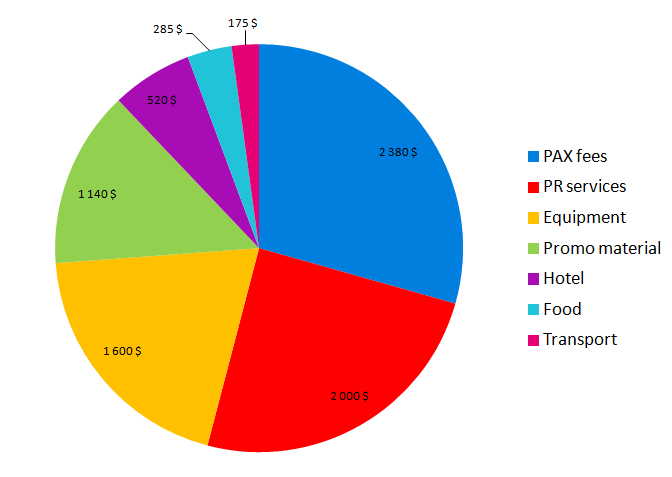
No, we won’t pay for that.
It’s important to note that, out of the $2,380 for the PAX related fees, there was one specific invoice that could have been avoided. We had a little issue with the company that handles pretty much all the logistics at PAX (Freeman).
Before ordering our TV stands, we called Freeman and explained that it was our very first PAX and that we had no idea how we could get the stands to our booth. We heard that we could have them shipped there, but we didn’t know what the process was, or what were the details.
The person we spoke with told us that we could simply have our equipment shipped at the convention center on a specific date, and they would take care of all the rest (get the stuff to our booth, etc). We were pretty surprised by how simple that was, and they confirmed that it was an included service for all exhibitors. We said “Really?”, they said “Yes”.

Well, that was easy! We simply ordered our TV stands online and had them shipped at the convention center. When we arrived at PAX, everything was neatly stacked at our booth. Awesome!
So on the last day of PAX, we receive a nice little invoice from Freeman, listing all the packages they had to carry to our booth. Since the TV stands weigh 175 lbs each, the invoice ramped up to about $900 USD… *spits coffee*

The good news is that, after placing some complaints at their office twice, debating over the fact someone on the phone told us the service was included, and demonstrating that paying $900 for $1000 worth of equipment while we came by car from Montreal made no sense at all, we managed to get the invoice dropped to $380. It’s still a lot of money very badly spent, but it’s better than $900.
Next time, we won’t use any of Freeman’s services by default. Heck, even using small rolling carts to move our equipment out after the show was expensive.
What went wrong
Not much actually, but there was still a couple things we’ll do differently next time.
- 1,000 flyers / buttons weren’t enough, we should have ordered 1,500.
- We should have printed more free keys from the start (at least 2,000).
- We had a lot of equipment to handle for just 3 people with a small car.
- The goat hat were cheap but wouldn’t fit well on everybody. We should make better hats for the next event.
- Big media appointments didn’t show up because of the snow / flights being canceled.
- Freeman charging too much for handling the equipment (and lying to us on the phone).
What went right
Overall, pretty much everything went right. We found a couple of new things that we’ll probably try to repeat for next events though, like:
- AirBnB was way cheaper than hotels.
- We used a Karma to get really cheap wifi for the whole event.
- Boston was close to Montreal, so it was possible to go by car and save a lot of money.
- The 2 TV stands helped a lot and made it easier for everyone to clearly see the game.
- Giving away keys attracted a LOT of people to our booth.
- Using the QR code trick for the keys also got us a couple extra emails in our newsletter (over 500 for one day, but could have been more if we would have used it from the start).
- The tournament system worked well, it was an easy solution for quick and simple tournaments.
- Being positioned on a corner definitely helped, especially with the crowd we had.
- Having only one playable station was definitely easier to manage with only 3 people.
So, was PAX East worth it?
Hell yes! We would totally do that again. We’ve never had such an engaged and fun crowd before. We totally connected with players and it felt great!
Hopefully you found something interesting in that super long post. If you have any questions, tips, suggestions or comments regarding our experience or the article, please share them in the comments below!


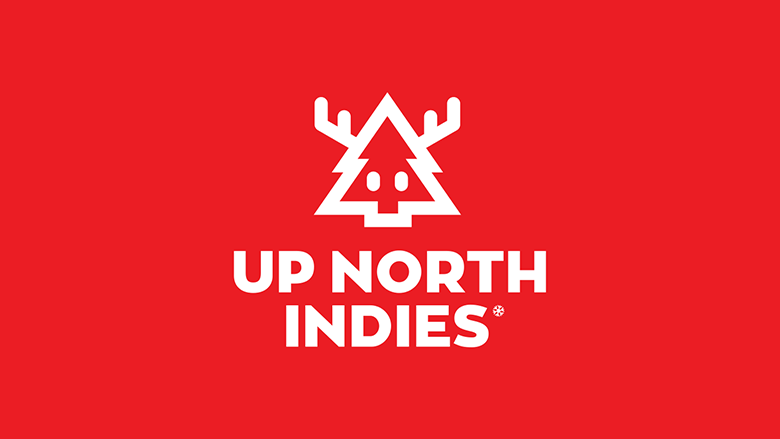

LOVED this game on Ouya and can’t wait to get in to it on Xbox. Glad to see such a huge turnout for you all at PAX as well. Good luck on your Summer launch!
Thanks Brad! We hope you’ll enjoy the new version too!
Awesome article, thanks for that!
That’s great for the Up North Indies, I’m glad to see that kind of collaboration.
Wish you all the best, you rock 🙂
Hopefully the UNI will grow bigger and stronger over time!
I think you did so many things right! All the ideas you had were great and I was able to get a steam key but I like the game so much that I’ll probably buy it to support you guys!! The fact that you’re from the same province as me probably influences my opinions too but I really find it awesome how four guys in a basement can make such good quality products! Good job guys!
Aw merci Simon! QC FTW! It’s really appreciated, thanks for taking the time let us know 🙂
Saw you guys on Friday and Sunday! My friends and I were so upset with how badly your bot beat us that we went back on Sunday and spent a lot of time trying to get those keys. We’re actually in that video! But seriously, we saw a lot of booths there, and we both agree that you guys probably had one of the best at the whole convention.
Oh wow, thanks! “One of the best” is awesome 😀
Thanks for the details, lots of good ideas here. Curious though, what was the $2000 in “PR services” in the pie chart?
It was yet another experiment on our part. We actually paid a PR firm (for the first time) to do media outreach for us. That means that they would contact people from the media and ask them if they’d like to have an appointment with us during the event to check the game out.
For instance, they organized an appointment with someone from Destructoid for us. So they came at our booth and asked us a lot of questions about the game, which then resulted in them writing an article on Destructoid.com -> http://www.destructoid.com/headbutting-for-goats-in-toto-temple-deluxe–288784.phtml
It’s always a gamble because you don’t know which media will accept to stop by your booth, plus you don’t know if their visit will generate an article or not. They might write one, but it might also not generate a lot of interest. So you never really know if PR will be worth it or not, depending on how much you paid for.
Every time I read one of your articles on game design or whatever I find it informative and insightful. : ) Taking notes from this one for my production debut/kickstarter push at Pax Prime!
Thanks! It’s always nice to hear that our posts are actually useful to someone 🙂
I have one of the QR keys and used it. I can’t wait to play it on steam & buy it for PS4 if you release it on that system. It was a blast!
We will! Thanks!
I kept stopping by the booth as much as possible over the weekend. I was in the video (bottom right with the glasses) and I also got to compete in one of the tournaments. This was my favorite booth for Pax this year. Last year, I had spent most of my time at the Riot Games booth. The time I spent outside of that booth I was able to find Brawlhalla (which was my favorite booth last year). Brawlhalla, Toto Temple Deluxe, and Porcunipine were more fun than any of the big booth games for me. I even bought another gamepad so that I could play with friends before keyboard support comes in. Great game, I can’t wait to see how it develops.
Wow, that is huge! Thanks a lot for stopping by, we totally appreciate the support 🙂
class awesome
{
public static void Main()
{
System.Console.WriteLine(“awesomegame!”);
}
}
I remember stopping at the booth and I could not just leave it.
Yes, I was there for so long, and I could have played other games and seen more things…
But this game was not a waste of time.
Wow thanks! We’re glad you enjoyed the game 🙂